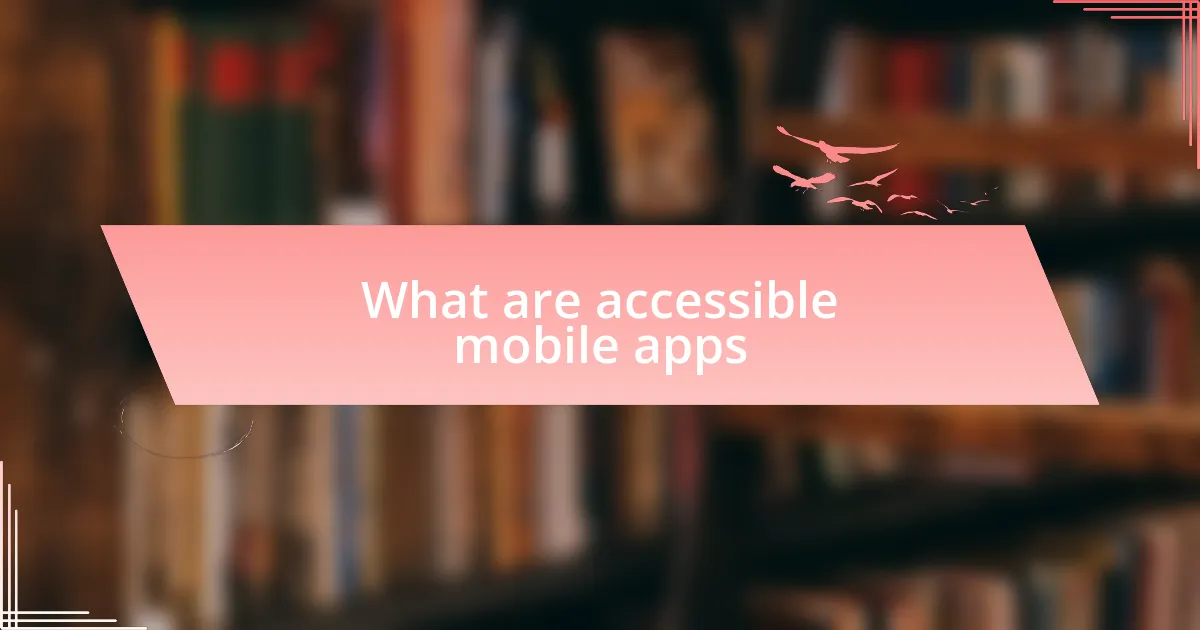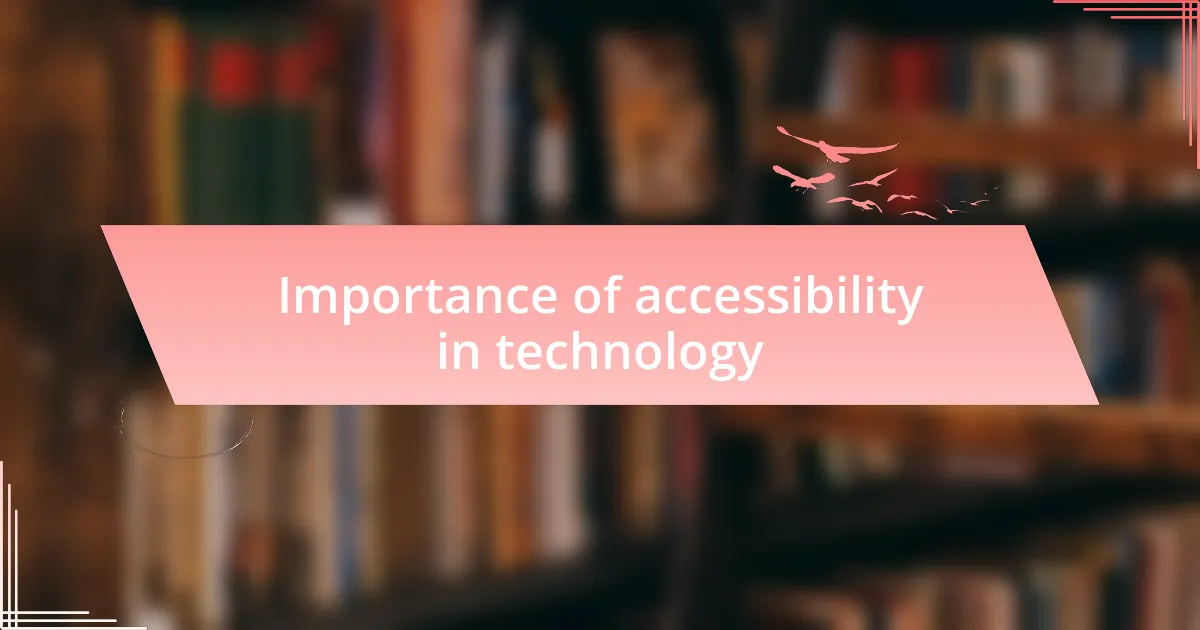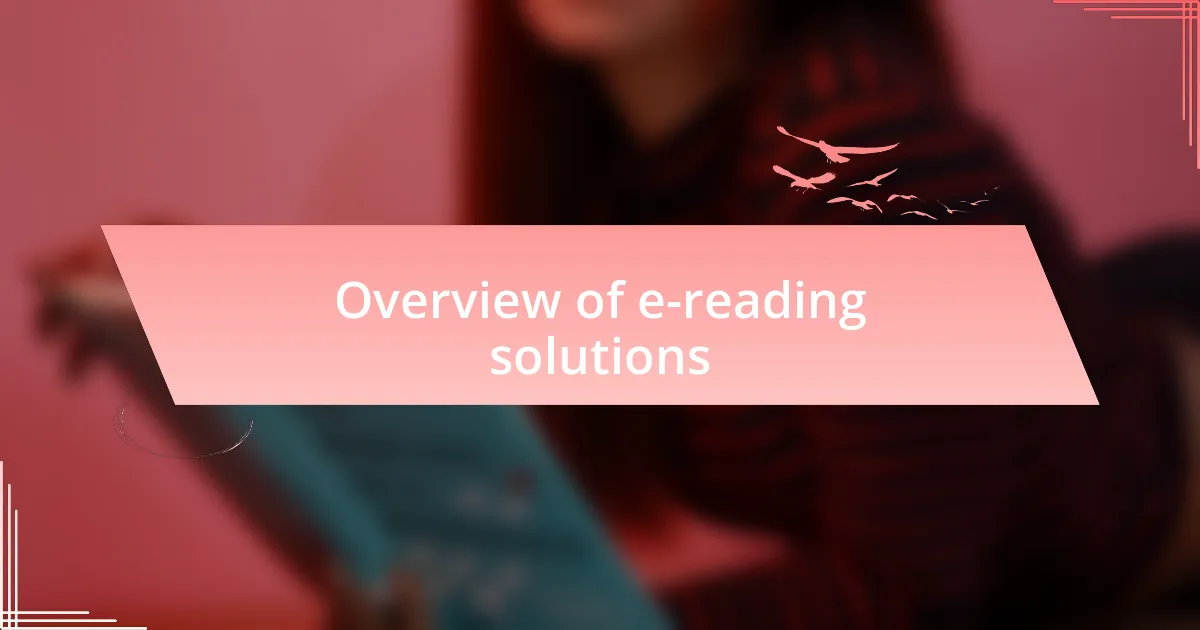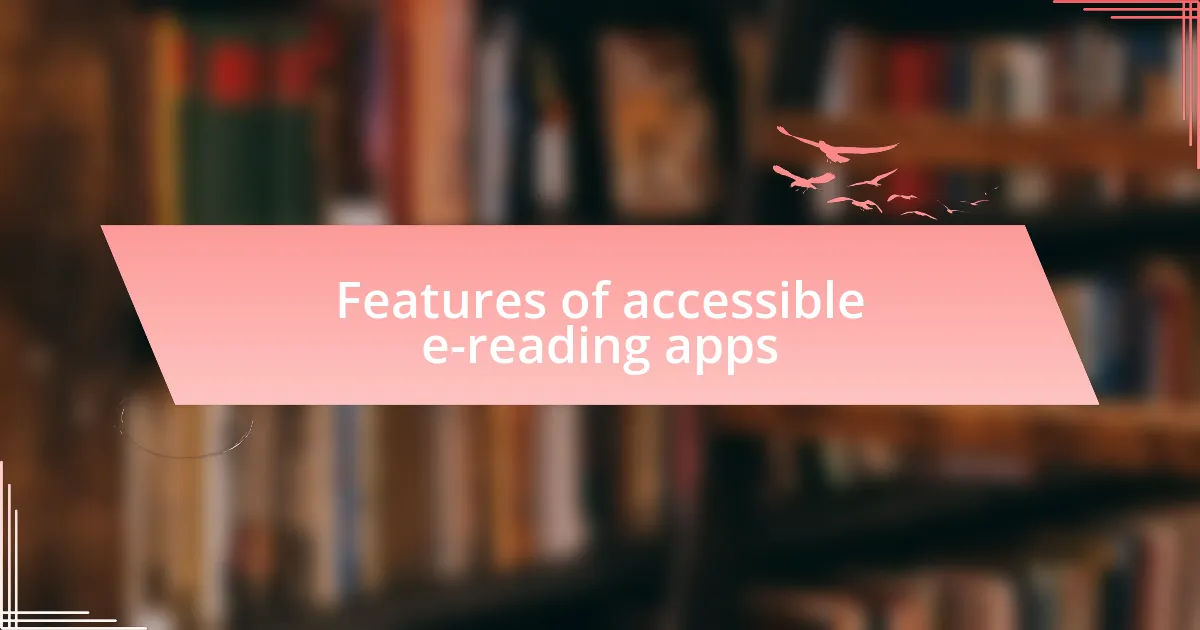Key takeaways:
- Accessible mobile apps are essential for inclusivity, providing features like voice screen readers and adjustable text sizes for diverse user needs.
- Technology accessibility enhances user experience and reflects a commitment to diversity, improving engagement for all users, not just those with disabilities.
- E-reading solutions have evolved, offering customizable features and multitasking options, making literature more accessible and enjoyable for everyone.
- Implementing voice commands, ensuring screen reader compatibility, and incorporating user feedback are crucial steps for improving accessibility in mobile apps.

What are accessible mobile apps
Accessible mobile apps are designed to ensure that everyone, regardless of their abilities, can easily navigate and use them. I once felt frustrated trying to use an app that wasn’t tailored for my visually impaired friend. It made me realize how crucial accessibility features, like voice screen readers and adjustable text sizes, are for making technology inclusive.
These apps go beyond basic functionality; they create an experience that empowers users. For instance, imagine a person with a hearing impairment trying to interact with an app that lacks captioning for audio content. They could miss out on vital information, making them feel excluded. This experience resonates deeply with me, as I believe that technology should enhance lives, not hinder them.
Moreover, accessible mobile apps embody a philosophy: technology should be for everyone. Have you ever wondered how life-changing it would be for someone with disabilities to fully engage with the digital world? This realization inspires me to advocate for smoother designs that prioritize usability for all, transforming everyday tasks into seamless experiences.

Importance of accessibility in technology
Accessibility in technology is vital because it ensures that everyone can participate fully in our increasingly digital world. I remember a time when a friend with motor disabilities struggled to fill out forms on various apps. It struck me how a simple feature like voice input or customizable interface controls could have made her experience so much better—allowing her to engage without barriers.
Not only does accessibility open doors for users with disabilities, but it also enriches the overall user experience. When I use apps with thoughtful design, I’m often amazed at how much easier they are to navigate. Have you ever tried a well-designed app that just feels intuitive? It’s almost like the developers considered every user’s journey, leading to a more satisfying interaction for everyone.
Furthermore, accessible technology reflects a commitment to diversity and inclusion. If businesses prioritize accessibility, they send a powerful message that every user matters. It makes me wonder, how different our world would be if we all acknowledged our shared responsibility to create inclusive spaces wherever technology is involved. Every small effort in this direction can lead to significant change, making a lasting impact on countless lives.

Overview of e-reading solutions
E-reading solutions have significantly evolved, providing users with diverse formats and features. I remember the first time I discovered reading apps that allowed me to adjust font sizes and background colors; it was eye-opening. Suddenly, I could tailor my reading experience to fit my preferences, making the content not just accessible but also enjoyable.
The range of e-reading options also includes audiobooks, interactive texts, and tools to assist those with visual impairments. I often think about how important these innovations are for individuals who might struggle with traditional printed materials. Have you ever considered how a well-crafted audio narration can bring a story to life, especially for someone who may find it difficult to focus on the written word?
Moreover, cloud-based platforms now allow users to sync their reading across devices. This feature is a game-changer. Imagine being able to start a book on your tablet at home and effortlessly continuing on your phone during your commute. It illustrates the beauty of modern technology; not only does it promote accessibility, but it also enhances the way we consume literature by blending convenience with personalization.

Features of accessible e-reading apps
When exploring the features of accessible e-reading apps, one standout characteristic is the ability to customize text formatting. I recall once struggling to read a particular digital book until I discovered a feature that allowed me to change the font to a more comfortable style. It’s amazing how small adjustments, like contrasting text colors or increasing the line spacing, can eliminate strain and transform the reading experience into something truly enjoyable for anyone.
Another vital feature is the integration of text-to-speech technology. I know from personal experience how beneficial this can be, especially during long commutes when my eyes tire easily. A single tap can turn any text into an engaging audio format, bringing stories to life while allowing me to multitask. Have you ever been captivated by the inflection and emotion in a narrator’s voice when listening to a book?
Furthermore, many apps now include comprehensive accessibility settings tailored for users with disabilities. I once used an e-reader with a screen reader option that provided a wealth of auditory features. Not only did this aid those with visual impairments, but it also made the app appealing to users like myself, who sometimes prefer to absorb information through listening rather than reading. Seeing diverse accessibility features come to life shows how technology can bridge gaps, making literature reachable to everyone.

My experiences with e-reading apps
My journey with e-reading apps has been transformative. I remember a time when pesky glare from my phone screen made reading virtually impossible, leading to frustration. Then I discovered an app with a night mode feature that turned my reading experience around completely. It was like finding a cozy reading nook in a dimly lit café, where everything feels just right.
One of the most interesting aspects I’ve encountered is the variety of reading formats an app can offer. I once opted to listen to a book rather than read it, thanks to the well-crafted audio versions available. The voice artist’s tones painted visuals in my mind, creating an immersive experience that often led me to imagine different scenarios beyond the pages. Have you ever felt more connected to a character through their voice than through the words alone?
I’ve also noticed the community features in some applications that allow readers to share their thoughts on books. Engaging in discussions with others about plot twists or themes felt refreshing, turning solitary reading into a shared experience. Once, I found myself in a lively conversation about a bestseller that deepened my understanding and appreciation, revealing layers I hadn’t noticed on my own. It truly highlights how technology can foster connections and enhance our literary journeys.

Benefits of accessible e-reading tools
Accessible e-reading tools bring significant benefits that enhance the overall reading experience. For instance, I recall a moment when adjusting the font size on an app made a remarkable difference in my comfort level. Suddenly, words that had previously felt daunting came to life, and it struck me how such a simple feature could empower readers to engage with texts more meaningfully. Isn’t it fascinating how just a tweak can open up a whole new world of literature?
Another advantage of these tools is the ability to customize background colors to reduce visual strain. I often found myself squinting at texts, not realizing the irritation caused by stark whites. Once I switched to a more soothing contrast, reading felt like a breath of fresh air. Imagine settling into a story with ease instead of battling discomfort—that’s the magic of accessibility.
Furthermore, the integration of text-to-speech technology is a game-changer for those who may struggle with traditional reading. I remember a friend who once dreaded long academic texts but found joy in listening to the content being read aloud. That simple shift transformed how they interacted with information. How could something so straightforward significantly alter our learning dynamics? The answer lies in the power of technology to cater to diverse needs.

Recommendations for improving accessibility
When it comes to improving accessibility in mobile apps, one key recommendation is to consistently implement voice commands. I remember the first time I used a voice-controlled feature; it felt revolutionary. This capability not only streamlined my interactions, but it also made using the app feel more intuitive, especially during those moments when my hands were tied, or my eyes were tired. Why shouldn’t every app offer this simple yet powerful enhancement?
Another vital consideration is ensuring compatibility with screen readers. I used to overlook this aspect until a friend pointed out how frustrating it can be when apps aren’t designed with these tools in mind. For me, it was an eye-opener; the content became inaccessible without proper formatting. By making sure all text is readable and properly labeled, developers can create an inclusive atmosphere where everyone can thrive.
Lastly, incorporating user feedback into the design process is crucial. Reflecting on my own experiences, I once provided suggestions on an app that transformed its interface for the better. Listening to the actual users leads to practical improvements that developers might not envision. So, why not establish a regular feedback loop? This way, users can directly contribute to making these platforms more accessible, ultimately benefiting the entire community.